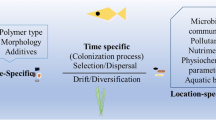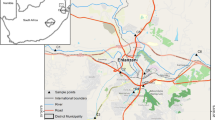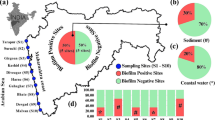Abstract
The impact of acid rock drainage (ARD) and eutrophication on microbial communities in stream sediments above and below an abandoned mine site in the Adelaide Hills, South Australia, was quantified by PLFA analysis. Multivariate analysis of water quality parameters, including anions, soluble heavy metals, pH, and conductivity, as well as total extractable metal concentrations in sediments, produced clustering of sample sites into three distinct groups. These groups corresponded with levels of nutrient enrichment and/or concentration of pollutants associated with ARD. Total PLFA concentration, which is indicative of microbial biomass, was reduced by >70% at sites along the stream between the mine site and as far as 18 km downstream. Further downstream, however, recovery of the microbial abundance was apparent, possibly reflecting dilution effect by downstream tributaries. Total PLFA was >40% higher at, and immediately below, the mine site (0–0.1 km), compared with sites further downstream (2.5–18 km), even after accounting for differences in specific surface area of different sediment samples. The increased microbial population in the proximity of the mine source may be associated with the presence of a thriving iron-oxidizing bacteria community as a consequence of optimal conditions for these organisms while the lower microbial population further downstream corresponded with greater sediments’ metal concentrations. PCA of relative abundance revealed a number of PLFAs which were most influential in discriminating between ARD-polluted sites and the rest of the sites. These PLFA included the hydroxy fatty acids: 2OH12:0, 3OH12:0, 2OH16:0; the fungal marker: 18:2ω6; the sulfate-reducing bacteria marker 10Me16:1ω7; and the saturated fatty acids 12:0, 16:0, 18:0. Partial constrained ordination revealed that the environmental parameters with the greatest bearing on the PLFA profiles included pH, soluble aluminum, total extractable iron, and zinc. The study demonstrated the successful application of PLFA analysis to rapidly assess the toxicity of ARD-affected waters and sediments and to differentiate this response from the effects of other pollutants, such as increased nutrients and salinity.






Similar content being viewed by others
References
J Aitchinson (1984) ArticleTitleReducing the dimensionality of compositional data sets. Math Geol 16 617–635
E Baath A Frostegard T Pennanen H Fritze (1995) ArticleTitleMicrobial community structure and pH response in relation to soil organic matter quality in wood-ash fertilized, clear-cut or burned coniferous forest soils. Soil Biol Biochem 27 229–240 Occurrence Handle10.1016/0038-0717(94)00140-V
E Baath M Diaz-Ravina A Frostegard CD Campbell (1998) ArticleTitleEffect of metal-rich sludge amendments on the soil microbial community. Appl Environ Microbiol 64 238–245 Occurrence Handle1:CAS:528:DyaK1cXitVartA%3D%3D
BH Baird DC White (1985) Biomass and community structure of the abyssal microbiota determined from the ester-linked phospholipids recovered from Venezuela basin and Puerto Rico trench sediments. DC Young MD Richardson (Eds) Benthic Ecology and Sedimentary Processes of Venezuela Basin—Past and Present Elsevier Amsterdam 217–231
D Banks PL Younger R Ameson ER Iverson SB Banks (1997) ArticleTitleMine-water chemistry: the good, the bad and the ugly. Environ Geol 32 157–174 Occurrence Handle10.1007/s002540050204
P Boon P Virtue PD Nichols (1996) ArticleTitleMicrobial consortia in wetland sediments: a biomarker analysis of the effects of hydrological regime, vegetation and season on benthic microbes. Mar Freshwat Res 47 27–41 Occurrence Handle1:CAS:528:DyaK28Xis1Kru7s%3D
CJF Braak P Smilauer (1998) Canoco Reference Manual Centre for Biometry, Wageningen The Netherlands
PL Brown RN Sylva GE Batley J Ellis (1985) ArticleTitleThe hydrolysis of metal ions. Part 8. Aluminium (III). J Chem Soc Dalton Trans . 1967–1970 Occurrence Handle10.1039/dt9850001967
JS Buyer LE Drinkwater (1997) ArticleTitleComparison of substrate utilisation assay and fatty acid analysis of soil microbial communities. J Microbiol Methods 30 3–11 Occurrence Handle10.1016/S0167-7012(97)00038-9 Occurrence Handle1:CAS:528:DyaK2sXlslersLo%3D
Carr, MR (1996) Primer User Manual—Plymouth Routines in Multivariate Ecological Research. Plymouth Marine Laboratory, United Kingdom
MA Cavigelli GP Robertson MJ Klug (1995) ArticleTitleFatty acid methyl ester (FAME) profiles as measures of soil microbial community structure. Plant Soil 170 99–113 Occurrence Handle1:CAS:528:DyaK2MXlt1Kgtbc%3D
I Dainis (2000) A conceptual model of the chemical loads in Dawesley Creek arising from acid sulfates in the Brukunga quarry. SJ Markich (Eds) Proceeding of the Third Brukunga Workshop. ANSTO/C616 Australian Nuclear Science and Technology Organization Sydney 8–35
FC Dobbs JB Guckert (1988) ArticleTitleCallianassa trilobata (Crustacea: Thalassinidea) influences abundance of meiofauna and biomass, composition, and physiologic state of microbial communities within its burrow. Mar Ecol Prog Ser 45 69
NJE Dowling F Widdel DC White (1986) ArticleTitlePhospholipid ester linked fatty acids biomarkers of acetate-oxidizing sulphate reducers and other sulphide-forming bacteria. J Gen Microbiol 132 1815–1825 Occurrence Handle1:CAS:528:DyaL28XkslGmt70%3D
A Edlund PD Nichols R Roffey DC White (1985) ArticleTitleExtractable and lipopolysaccharide fatty acid hydroxy acid profiles from Desulfovibrio species. J Lipid Res 26 982–988 Occurrence Handle1:CAS:528:DyaL2MXlsFKqtLc%3D Occurrence Handle4045322
RJ Ellis B Neish MW Trett JG Best AJ Weightman P Morgan JC Fry (2001) ArticleTitleComparison of microbial and meiofaunal community analyses for determining impact of heavy metal contamination. J Microbiol Methods 45 171–185 Occurrence Handle10.1016/S0167-7012(01)00245-7 Occurrence Handle1:CAS:528:DC%2BD3MXjtlegu78%3D Occurrence Handle11348675
J Fang RH Findlay (1996) ArticleTitleThe use of classic lipid extraction method for simultaneous recovery of organic pollutants and microbial lipids from sediments. J Microbiol Methods 27 63–71 Occurrence Handle10.1016/0167-7012(96)00929-3
Ferris, JM, Brown, PL, Holden, PJ (2000) “Risk-based assessment method for impact on riverine ecosystems.” Proceedings Third AMEEF Innovation Conference, On the Threshold: Research into Practice. Brisbane, Queensland, 15–17 August, pp 52–55
RH Findlay GM King L Watling (1989) ArticleTitleEfficacy of phospholipid analysis in determining microbial biomass in sediments. Appl Environ Microbiol 54 2888–2893
RH Findlay L Watling LM Mayer (1995) ArticleTitleEnvironmental impact of salmon net-pen culture on marine benthic communities: A case study. Estuaries 18 145–179 Occurrence Handle1:CAS:528:DyaK2MXotFGmsrs%3D
RH Findlay (1996) The use of phospholipid fatty acids to determine microbial community structure. ADL Akkermans JD Van Elsas FJ De Bruijn (Eds) Molecular Microbial Ecology Manual Kluwer Academic Publishers Dordrecht 4.1.4:1–17
RH Findlay L Watling (1997) Seasonal variation in sedimentary microbial community structure as a backdrop for the detection of anthropogenic stress. RP Eganhouse (Eds) Molecular Markers in Environmental Geochemistry ACS Press Washington, DC 49–64
PD Franzmann BM Patterson TR Power PD Nichols GB Davis (1996) ArticleTitleMicrobial biomass in a shallow, urban aquifer contaminated with aromatic hydrocarbons: analysis of phospholipid fatty acid content and composition. J Appl Bacteriol 80 617–625 Occurrence Handle1:CAS:528:DyaK28Xkt1Ojtr4%3D Occurrence Handle8698663
A Frostegard A Tunlid E Baath (1993) ArticleTitlePhospholipid fatty acid composition, biomass, and activity of microbial communities from two soil types experimentally exposed to different heavy metals. Appl Environ Microbiol 59 3605–3617
M Ghosh K Mishra (1985) ArticleTitleEffect of cultural conditions on the lipid profile of Thiobacillus ferrooxidans. Arch Microbiol 143 297–301 Occurrence Handle1:CAS:528:DyaL28XmsFGjsQ%3D%3D
FT Gillan RW Hogg (1984) ArticleTitleA method for the estimation of bacterial biomass and community structure in mangrove-associated sediments. J Microbiol Methods 2 275–293 Occurrence Handle1:CAS:528:DyaL2cXlvVOiu7g%3D
R Hadley D Snow (Eds) (1974) Water Resources and Problems Related to Mining American Water Resources Association MN
Harries, J (1997) Acid Mine Drainage in Australia. Office of the Supervising Scientist Report No. 125, Darwin.
AT Herlihy AL Mills GM Hornberger AE Bruckner (1987) ArticleTitleSulfate reduction in freshwater sediments receiving acid mine drainage. Appl Environ Microbiol 49 179–186
R Jeffree J Ferris P Holden S Markich J Twining (1998) Indicators of rehabilitation success in aquatic ecosystems. CJ Asher LC Bell (Eds) Proceedings of Workshop on Indicators of Ecosystem Rehabilitation Success, 23–24 October, 1998 Melbourne Australia 22–30
DB Johnson (1995) ArticleTitleAcidophilic microbial communities: candidates for bioremediation of acidic mine effluents. Int Biodet Biodeg . 41–58 Occurrence Handle10.1016/0964-8305(95)00065-D
DB Johnson FF Roberto (1997) Heterotrophic acidophiles and their role in the bioleaching of sulphide minerals. D. Rawlings (Eds) Biomining: Theory, Microbes and Industrial Processes Springer-Verlag Berlin 259–279
T Kaneda (1991) ArticleTitleIso- and anteiso-fatty acids in bacteria: Biosynthesis, function and taxonomic significance. Microbiol Rev 55 288–302 Occurrence Handle1:CAS:528:DyaK3MXltlWnt7g%3D Occurrence Handle1886522
Y Katayama-Fujimura N Tsuzaki H Kuraishi (1982) ArticleTitleUbiquinone, fatty acids and DNA based composition determination as a guide to taxonomy of the genus Thiobacillus. J Gen Microbiol 128 1599–1611 Occurrence Handle1:CAS:528:DyaL38Xlslynsr0%3D
JJ Kelly M Haggblom RL Tate III (1999) ArticleTitleChanges in soil microbial communities over time resulting from one time application of zinc: a laboratory microcosm study. Soil Biol Biochem 31 1455–1465 Occurrence Handle10.1016/S0038-0717(99)00059-0 Occurrence Handle1:CAS:528:DyaK1MXltVOks7Y%3D
M Kelly (1988) Mining and the Freshwater Environment Elsevier Applied Science Cambridge, UK 43–63
BD Kerger PD Nichols CP Antworth W Sand E Bock JC Cox TA Langworthy DC White (1986) ArticleTitleSignature fatty acids in the polar lipids of acid producing Thiobacillus spp.: methoxy, cyclopropyl, alpha-hydroxy-cyclopropyl and branched and normal monoenoic fatty acids. FEMS Microbiol Ecol 38 66–77
RLP Kleinman DA Crerar RR Pacelli (1981) ArticleTitleBiochemistry of acid mine drainage and a method to control acid formation. Min Eng 33 300–305
K Komagata KI Suzuki (1987) Lipid and cell wall analysis in bacterial systematics. RR Colwell R Grigorova (Eds) Methods in Microbiology Academic Press London 165–183
RM Kroppenstedt (1985) Fatty acid and menaquinone analysis of actinomycetes and related organisms. M Goodfellow DE Minnikin (Eds) Chemical Methods in Bacterial Systematics Academic Press London 173–199
K Lawlor BP Knight VL Barbosa-Jefferson PW Lane AK Lilley GI Paton SP McGrath SM O’Flaherty PR Hirsch (2000) ArticleTitleComparison of methods to investigate microbial populations in soils under different agricultural management. FEMS Microbiol Ecol 33 129–137 Occurrence Handle10.1016/S0168-6496(00)00053-2 Occurrence Handle1:CAS:528:DC%2BD3cXmtVCrurc%3D Occurrence Handle10967212
MP Lechevalier (1977) ArticleTitleLipids in bacterial taxonomy, a taxonomist’s view. Crit Rev Microbiol 5 109–210 Occurrence Handle1:CAS:528:DyaE2sXhtlGqtbk%3D
RM Lehman FS Colwell DB Ringelberg DC White (1995) ArticleTitleCombined microbial community level analyses for quality assurance of terrestrial subsurface cores. J Microbiol Methods 22 263–281 Occurrence Handle10.1016/0167-7012(95)00012-A
T Pennanen F Hannu P Vanhala O Kiikkila S Neuvonen E Baath (1998) ArticleTitleStructure of a microbial community in soil after prolonged addition of low levels of simulated acid rain. Appl Environ Microbiol 64 2173–2180
JT Pronk DB Johnson (1992) ArticleTitleOxidation and reduction of iron by acidophilic bacteria. Geomicrobiol J 10 153–171 Occurrence Handle1:CAS:528:DyaK2cXhsFyhsLg%3D
N Rajendran O Matsuda (1995) ArticleTitleFatty acid analysis to determine the seasonal variation in microbial biomass and its community structure of coastal sediments. J Fac Appl Biol Sci, Hiroshima Univ. 34 21–32
C Ratledge SG Wilkinson (1988) Microbial Lipids, Vol. 1 Academic Press London
JN Russell DS Nichols (1999) ArticleTitlePolyunsaturated fatty acids in marine bacteria—a dogma rewritten. Microbiology 145 767–779 Occurrence Handle1:CAS:528:DyaK1MXisFWrsb4%3D Occurrence Handle10220156
DE Rawlings (1997) Mesophilic, autotrophic bioleaching bacteria: description, physiology and role. D Rawlings (Eds) Biomining: Theory, Microbes and Industrial Processes Springer-Verlag Berlin 229–245
D Schulze-Makuch JF Kennedy (2000) ArticleTitleMicrobiological and chemical characterization of hydrothermal fluids at Tortugas Mountain Geothermal Area, southern New Mexico, USA. Hydrogeol J 8 295–309 Occurrence Handle10.1007/s100400050016 Occurrence Handle1:CAS:528:DC%2BD38Xkt1GrtLg%3D
GA Smith JS Nickels BD Kerger JD Davis SP Collins JT Wilson JF McNabb DC White (1985) ArticleTitleQuantitative characterization of microbial biomass and community structure in subsurface material: a prokaryotic consortium responsive to organic contamination. Can J Microbiol 32 104–111
CC Steward SC Nold DB Ringelberg DC White CR Lovell (1996) ArticleTitleMicrobial biomass and community structures in the burrows of bromophenol producing and non-producing marine worms and surrounding sediments. Mar Ecol Prog Ser 133 149–165
I Sundh M Nilsson P Borga (1997) ArticleTitleVariation in the microbial community structure in two boreal peatlands as determined by analysis of phospholipid fatty acids profiles. Appl Environ Microbiol 63 476–14
A Tunlid DC White (1990) Use of lipid biomarkers in environmental samples. A Fox SL Morgan L Larsson G Odham (Eds) Analytical Microbiology Methods Plenum Press New York 259–273
RJ Vestal DC White (1989) ArticleTitleLipid analysis in microbial ecology: quantitative approaches to the study of microbial communities. Bioscience 39 535–541 Occurrence Handle1:STN:280:DC%2BD3MnmtVOmtw%3D%3D Occurrence Handle11542183
PFM Verdonschot CJF Ter Braak (1994) ArticleTitleAn experimental manipulation of oligochaete communities in mesocosms treated with chlorpyrifos or nutrient addition: multivariate analysis with Monte Carlo permutation tests. Hydrobiologia 278 251–266
JK Volkman RB Johns FT Gillan GJ Perry HJ Bavor (1980) ArticleTitleMicrobial lipids of an intertidal sediment. I. Fatty acids and hydrocarbons. Geochim Cosmochim Acta 44 1133–1143 Occurrence Handle10.1016/0016-7037(80)90067-8 Occurrence Handle1:CAS:528:DyaL3cXmtVOrtL4%3D
KC Walton DB Johnson (1992) ArticleTitleMicrobial and chemical characteristics of an acidic stream draining a disused copper mine. Environ Pollut 76 169–175 Occurrence Handle10.1016/0269-7491(92)90105-J Occurrence Handle1:CAS:528:DyaK38XhvVSls7w%3D Occurrence Handle15091999
DC White WM Davis JS Nickels JD King RJ Robbie (1979) ArticleTitleDetermination of the sedimentary biomass by extraction of lipid phosphate. Oecologia 40 51–62 Occurrence Handle10.1007/BF00388810
White, DC, Robbie, RJ, Herron, JS, King, JD, Morrison, SJ (1979) “Biochemical measurements of microbial biomass and activity from environmental samples.” In: Native Aquatic Bacteria: Enumeration, Activity and Ecology. ASTM STP 695.
DC White CA Flemming KT Leung SJ Macnaughton (1998) ArticleTitleIn situ microbial ecology for quantitative appraisal, monitoring, and risk assessment of pollution remediation in soils, the subsurface, the rhizosphere and in biofilms. J Microbiol Methods 32 93–105 Occurrence Handle10.1016/S0167-7012(98)00017-7 Occurrence Handle1:CAS:528:DyaK1cXis1Cksbo%3D
Acknowledgments
We thank the Analytical Chemistry group, Environment Division, ANSTO, for water quality analysis. The constructive comments on the manuscript by Peter D. Nichols are gratefully acknowledged.
Author information
Authors and Affiliations
Corresponding author
Rights and permissions
About this article
Cite this article
Ben-David, E., Holden, P., Stone, D. et al. The Use of Phospholipid Fatty Acid Analysis to Measure Impact of Acid Rock Drainage on Microbial Communities in Sediments. Microb Ecol 48, 300–315 (2004). https://doi.org/10.1007/s00248-003-1045-4
Received:
Accepted:
Published:
Issue Date:
DOI: https://doi.org/10.1007/s00248-003-1045-4




